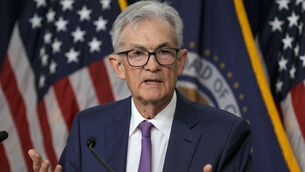Oliver Mangan: The differing outlooks for the world economies

Composite PMIs, a good leading indicator of economic activity, fell deeper into contraction in October in the eurozone, UK and US. Picture: Larry Cummins
Weakening survey data in particular are pointing to the growing risks of a recession in some of the major world economies. Composite PMIs, a good leading indicator of economic activity, fell deeper into contraction in October in the eurozone, UK and US, at well below the 50 mark.
The UK looks to be already in recession, with the Bank of England estimating GDP declined by 0.5% in the third quarter and projecting it will fall by a further 0.3% in this quarter.
The British economy faces more significant headwinds than elsewhere from both monetary and fiscal tightening and the damage being inflicted on external trade from Brexit. The bank sees GDP contracting in both 2023 and 2024.
The US Fed and ECB are more positive about their economies, which continued to expand in the third quarter. US GDP rose by 0.7% in this quarter. US GDP data have been volatile this year owing to erratic movements in inventories and net trade.
The domestic economy, though, has held up reasonably well, apart from the collapsing housing market which has been hard hit by the sharp rise in mortgage rates. A strong labour market, characterised by robust job growth, is helping to underpin activity. Most forecasters expect the US economy to avoid a recession in 2023.
Eurozone GDP rose by 0.2% in the third quarter after a strong performance in the first half of the year.
However, storm clouds are gathering for the euro area economy, with the war in Ukraine casting a long shadow. Inflation hit 10.7% in October.
This is weighing heavily on real household incomes and spending power. The economy has lost considerable momentum in the second half of the year.
We are likely to see eurozone GDP decline in both the final quarter of this year and opening quarter of 2023, a technical recession. One ray of hope has been the sharp fall in gas prices in the past two months, which should allow inflation to fall back.
However, there remains considerable uncertainty about the security of European gas supplies in 2023, which represents a significant downside risk for the economy next year.
The differing outlooks for the three economies was reflected in the recent policy meetings of their respective central banks. Very unusually, the Bank of England took issue with the markets, which are pricing in a considerable amount of additional rate tightening. It clearly guided that British rates will not need to rise that much further and certainly by less than markets are anticipating.
Meantime, the ECB noted the increasing downside risks to the eurozone economy and the possibility of recession. It called out the substantial tightening of policy since mid-year. This suggests rates will not need to rise beyond the 3% level priced in by markets.
By contrast, a hawkish Fed chairman said the US still has some way to go in its tightening cycle even though rates are now close to 4%, and that policy will need to be tightened more than it had previously expected.
Thus, markets are now looking for US rates to peak at above 5%. Overall, quite different views on rates from central banks for their differing economies.
- Oliver Mangan is chief economist with AIB













